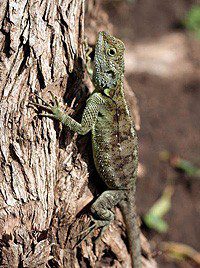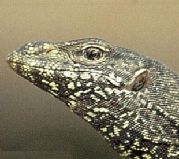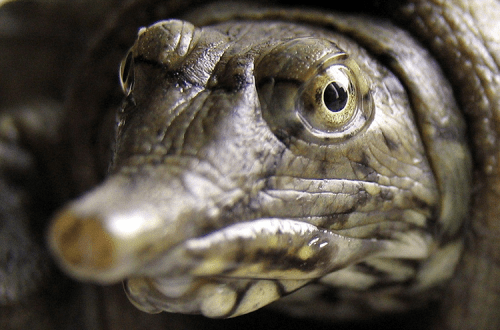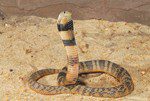
Central Asian cobra
This is a fairly large snake, the length of which reaches an average of 1,6 – 1,8 meters. Her scales are smooth, the pupil is round. Color can vary from light brown to dark brown. The belly is yellowish.
It lives in the territories of Turkmenistan, Tajikistan, Uzbekistan, Iran, Afghanistan, Pakistan, India. It occurs in the mountains at altitudes up to 1500 meters above sea level. Prefers hilly areas with plenty of cover.
The main diet of this cobra is amphibians, reptiles, rodents and small birds.
Sexually mature age occurs at 3-4 years. Mating takes place in the spring. The snake makes a clutch of 8-12 eggs in the middle of summer. Offspring are born in September.
The poison of the Central Asian cobra is deadly. It has a neurotoxic effect, causing convulsions, paralysis of the respiratory tract. However, deaths are recorded quite rarely, due to the preventive actions of the Central Asian cobra. When danger arises, it hisses loudly and, raising the front of the body, expands its flattened neck in the form of a “hood”, spreading the front eight pairs of cervical ribs to the sides. If such a threatening posture is not enough, then the cobra can inflict a fake bite – it hits the enemy with its head, while not opening its mouth, thus protecting its teeth from damage.
Contents
Description.
This species is not numerous anywhere in its territories. It does not form clusters, unlike some other species. Even in the most favorable habitats in the warm season, it is unlikely that you will be able to meet more than 2-3 snakes in one day. The maximum population density was registered in the south-west of Kopetdag – about 50 individuals per 1 square kilometer. The average population density of the Central Asian cobra is 3-5 individuals per square kilometer.
The peak of activity of the Central Asian cobra falls on spring time – during this period it leads mainly a daytime lifestyle. In the summer, when it is too hot for her during the daytime, she appears only in the evening hours and early in the morning. In autumn, the cobra is also active during the daytime, but it still comes to the surface of the earth much less often than it does in the spring.
Representatives of this species are quite large – the body length reaches 1 – 6 m. Its scales are smooth, not expanded on the ridge, there are no apical fossae, located in more or less transverse zigzag rows. Two or three postorbital shields, one preorbital. The third labial is the tallest of the labials. The first row of temporal scutes usually contains two large scutes. The body is encircled by 1 to 8 rows of scales. There are 19 to 21 ventral shields, 194 to 206 pairs of caudal shields.
The color of the upper side of the body varies from light to black-brown. The belly of this snake is yellowish. Juveniles have a contrasting ringed coloration, black stripes pass to the belly. As they grow older, the main tone of the color is darker, the transverse stripes fade and become wider, disappearing on the belly. Specks or spots form on it. The pupils are round. The head of the Central Asian cobra in a calm state is not limited from the body, which, in turn, passes into a smoothly tapering tail. Unlike the Indian cobra, the Central Asian cobra does not have a pattern in the form of glasses on the hood.
Classification.
Kingdom: Animalia (animals)
Type: Chordata
Class: Reptilia (reptiles)
Order: Squamata (scaly)
Suborder: Serpentes (snakes)
Family: Elipidae (aspididae)
Genus: Naja (real cobras)
Wil: Naja oxiana (Central Asian cobra)
Spread.
 The Central Asian cobra is distributed in the territories of Southern Turkmenistan, the South of Uzbekistan, the South-West of Tajikistan, Iran, the North-West of India, and Pakistan. It practically does not cross the limit of 1500 m above sea level. It mainly lives in hilly areas with a lot of shelters, as rocky mounds, and rodent burrows. In mountainous areas, it can be found in gorges and river valleys. It can also settle close to a person – on irrigated lands, in villages, in ruins. In the hot season, this cobra appears on the surface only in the morning and evening.
The Central Asian cobra is distributed in the territories of Southern Turkmenistan, the South of Uzbekistan, the South-West of Tajikistan, Iran, the North-West of India, and Pakistan. It practically does not cross the limit of 1500 m above sea level. It mainly lives in hilly areas with a lot of shelters, as rocky mounds, and rodent burrows. In mountainous areas, it can be found in gorges and river valleys. It can also settle close to a person – on irrigated lands, in villages, in ruins. In the hot season, this cobra appears on the surface only in the morning and evening.
habitation.
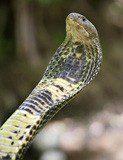 The Central Asian cobra is distributed in the territories of Turkmenistan (excluding the extreme northwestern regions), Uzbekistan (not the north extending to the Nura-Tau ridge, the western spurs of the Turkestan ridge and the Bel-Tau-Ata mountains), South-West Tajikistan, Afghanistan, Iran, North- western India, Pakistan. Cobra practically does not cross the limit of 1500 m above sea level. It generally prefers to be located in hilly areas with a lot of cover, such as, for example, rocky mounds, and rodent burrows. In mountainous areas, the Central Asian cobra can be found in gorges and river valleys. It can also be found many kilometers from the nearest water bodies, in the depths of a waterless desert. Quite often, she settles close to a person – on irrigated lands, in villages, in ruins.
The Central Asian cobra is distributed in the territories of Turkmenistan (excluding the extreme northwestern regions), Uzbekistan (not the north extending to the Nura-Tau ridge, the western spurs of the Turkestan ridge and the Bel-Tau-Ata mountains), South-West Tajikistan, Afghanistan, Iran, North- western India, Pakistan. Cobra practically does not cross the limit of 1500 m above sea level. It generally prefers to be located in hilly areas with a lot of cover, such as, for example, rocky mounds, and rodent burrows. In mountainous areas, the Central Asian cobra can be found in gorges and river valleys. It can also be found many kilometers from the nearest water bodies, in the depths of a waterless desert. Quite often, she settles close to a person – on irrigated lands, in villages, in ruins.
Yad.
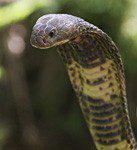 The poison of this snake is extremely strong – in addition to paralyzing the nerves, it also destroys the blood. By itself, its poison is a complex mixture of toxic polypeptides, proteins with specific biological properties and enzymes. It causes a wide pathological reaction of the body, which affects the most important organs and systems: the peripheral nervous and central systems, the endocrine and cardiovascular systems, the kidneys and liver, the hematopoietic organs and the blood itself.
The poison of this snake is extremely strong – in addition to paralyzing the nerves, it also destroys the blood. By itself, its poison is a complex mixture of toxic polypeptides, proteins with specific biological properties and enzymes. It causes a wide pathological reaction of the body, which affects the most important organs and systems: the peripheral nervous and central systems, the endocrine and cardiovascular systems, the kidneys and liver, the hematopoietic organs and the blood itself.
When bitten, the venom of the Central Asian cobra has a neurotoxic effect. After the bite, the victim becomes lethargic, but soon the body begins to shake convulsions, breathing quickens, becomes superficial. Death occurs after a while due to paralysis of the respiratory tract. When a large dose of cobra venom enters the bloodstream, which happens when bitten near large vessels, hemodynamic shock may develop. Local manifestations (hematomas, tumors) do not occur with the bite of the Central Asian cobra.
Despite the danger, this snake bites quite rarely, preferring to take a defensive posture when danger approaches, and hisses loudly, raising the front of the body and spreading the front eight pairs of cervical ribs to the sides in such a way that the flattened neck expands in the form of a “hood”. Usually, this is enough to convince the enemy to retreat. Although, even if the enemy does not heed the warnings, this is not always followed by a bite. First, the cobra inflicts a fake bite – throwing the front of the body sharply forward and hitting the enemy with its head. The mouth is closed during this blow. Thus, the snake protects its teeth from possible injury.
The very manner of bite, in the Central Asian cobra, is quite peculiar. If vipers inflict an instant prick with their long teeth and in the next moment throw their heads back, then a cobra, whose teeth are many times shorter, most often does not hope for a lightning prick. Usually she clings to her prey and not only does not lean back immediately, but also squeezes the jaws on the body of her victim several times with force and, as it were, “goes through” the jaws in order to surely sink her poisonous teeth into the body of the victim and inject the required amount of poison .
The venom of the Central Asian cobra is used in the production of anti-snake serums. The neurotoxins of its poison are used to study acetylcholine receptors and their molecular organization. Anticomplementary factors are used as immunosuppressants in scientific research. Enzymes from the venom of the Central Asian cobra are used in biochemical experiments.
Also, the poison of the Central Asian cobra is used for the manufacture of medicinal preparations. A sedative and analgesic is prepared from it, which is used for cardiovascular and other diseases.
Help with a bite.
First aid for the bite of the Central Asian cobra – the introduction of polyvalent anti-snake serum or serum “Anticobra”, the use of corticosteroids, anticholinesterase drugs in combination with atropine, the use of antihypoxants.
In case of deep breathing disorder, artificial ventilation of the lungs will be required.
Food.
The main diet of the Central Asian cobra is amphibians (lake frogs and green toads). It also feeds on various reptiles (snakes, such as efas, small boas, lizards), small birds (nightjars and small passerines) and rodents, and can ruin bird masonry.
Breeding.
The Central Asian cobra becomes sexually mature at the age of 3-4 years. The mating season for this species is in the spring. In the middle of summer, the female makes a clutch of 8-12 eggs, the average length of which is about 35 mm. In early autumn, offspring appear. Young growth is born about 30 cm in size.
Advanced.
The characteristic menacing posture of a cobra is an innate element that is transmitted at the genetic level. Even newly hatched snakes vertically raise the front of the body and extend the neck at the slightest danger. Due to this behavior of a cobra in natural conditions, it is extremely rare to be bitten by this cobra.
There are very few reliable cases of a bite of a Central Asian cobra by a person in the territories of the countries of the former USSR, and cases of death of livestock from a bite of this cobra are also rare.
The Central Asian cobra is listed in the IUCN Red List. For the Central Asian cobra, a more favorable situation exists in sandy deserts; in other habitats, its numbers are declining, mainly due to the destruction of its habitat. The most vulnerable are those populations that are located in the foothills, foothill deserts, river valleys – that is, where, due to fairly intensive economic development, the habitat of the Central Asian cobra is being destroyed.
In 1994, the Sberbank of Russia in the Red Book series issued a silver collector’s coin “Central Asian Cobra”.
Of the 10 species of cobras, the Central Asian cobra is the only one that can be found on the territory of Russia.
Sources.
http://www.kobri.narod.ru
http://www.apus.ru
http://zoology.edu.ru
http://www.ecosystema.ru
http://www.floranimal.ru



